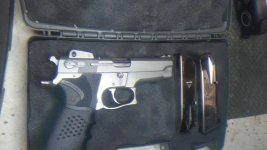This model, with fixed sights, was our department issue for a long time. As I recall, S&W recognized there was a problem with the extractor spring's tension and their solution was to retrofit a "nested" extractor spring. It was a simple fix and it worked.
Just for the sake of conversational trivia ...
We also carried early 3rd gen 59XX/69XX series pistols, and I was an armorer for them for some years.
It wasn't said to us that there was a particular problem with the extractor springs in those older guns. It was more a combination of the older guns, made using some early hand-controlled machining operations with a more generous tolerance spec range, and having to replace an occasional worn out or a "light" extractor spring.
The "repair" extractor spring kit (now long "obsolete") included a standard size spring and an older thin "inner" spring, making it a "nested" set of springs. Together, they could bump up the tension into the proper range for a particular gun.
We were told the reason for the nested springs was that the bottom surface of an occasional older extractor spring hole, in some particular slide, might not have been machined fully flat due to early machining methods.
The nested springs repair kit (part #19134) was their original attempt to let armorers find the right spring tension when replacing an extractor spring that was too light or worn out, but couldn't do it with a single spring because the standard single spring was too light, or an optional heavier spring might not fully fit down inside the hole and let you pin the extractor back in place.
We were also told that if using the nested springs, we might find that the standard spring rate range would be too light for an occasional older 59XX gun, and we might have to use a spring tension that was a pound or 2 above the upper end of the standard range. This was stressed that it had to be
carefully done, because it involved a delicate balance of having enough tension to to prevent failures-to-extract, but not too much that it resulted in failures-to-feed. I remember being told that while the force dial gauge and bar/flag gauges (to fit the extractor) were necessary bench checks, the final real test for repair occurred down range, on the firing line. The gun had to function with whatever duty ammunition you might be using.

A Wagner Force Dial Gauge was sold to armorers to use to check extractor spring tension, of the appropriate lighter calibration and with the proper extension to hold an extractor hook. Not a cheap tool, at about $150 plus shipping.
We replaced quite a few worn or light extractor springs with the nested kits before they were made obsolete, and it did, indeed, require bumping up the tension above the normally listed spring rates (in the armorer manuals) in at least one of them, as I recall, in order to get normal function. My own issued 5903 got one of the nested kits, and afterward it ran just fine for several years and several thousand rounds, later being issued to another user (until eventually replaced by the new TSW's).
I talked to one of the factory repair techs about this issue one time, and he said that at the factory they might sometimes use a hand-powered ball end mill to square any unevenly machined extractor spring holes in one of those older slides, so they could use the standard extractor spring and get it to fit and sit flat. That wasn't taught to armorers, though.
They eventually came up with a newer replacement extractor spring repair kit for the older 3rd gen 59XX guns, and made the nested spring set "obsolete". The new set contained 2 different springs (different rates, and also painted different colors), and 1 of them would usually let armorers replace an older or lighter spring and obtain a tension within the standard recommended range. It worked when I tried it a couple times, as I recall.
Now, S&W offered a range of different extractor springs for their different 3rd gen guns for armorers to use, which varied a bit by model/caliber.
There were a mix of Standard, Lighter, Extra light & Heavier than standard for the different 9/.40 guns. The spring rate range recommendations varied by model and caliber, including by whether it was a 39 series or a 59/69 series, and in the 59/69 series by whether it was an old or new bolt face design (round or straight cut bolt face). There was some cross-use of springs among the 9/.40 models (not counting the nested repair set), and then later there was even at least one (as I recall running across) spring made for a specific .40 production model which wasn't on the "list" of standard & optional springs for other models. The .45/10 guns had 3 springs, Standard, Heavy & Extra-Heavy.
OP, I'd also recommend sending the gun back to the factory, or, if the factory either won't do it, or wants too much, maybe try calling that guy in Texas who used to be a longtime factory authorized repair center. I never had to use him, being an armorer, but I think this link is him. You'd have to call.
LSG, Mfg|Gun Parts|Warranty|Gunsmithing






